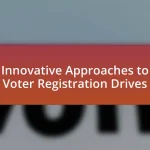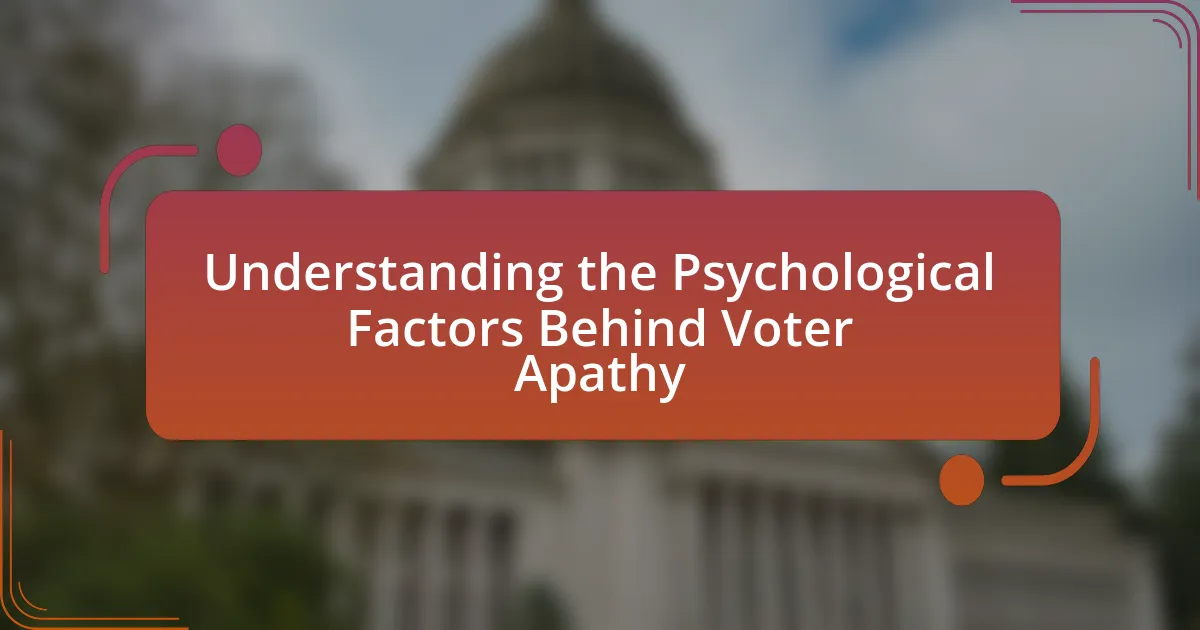Virtual Town Halls are online platforms that facilitate direct engagement between elected officials or candidates and constituents, enhancing voter participation through real-time discussions and feedback. This article explores the purpose, benefits, and challenges of Virtual Town Halls in fostering civic engagement, particularly among younger voters and those facing geographical barriers. It examines the technology used to host these events, the impact of social media in promoting them, and how the COVID-19 pandemic has accelerated their adoption. Additionally, the article discusses best practices for organizing successful Virtual Town Halls and the future potential of integrating advanced technologies to improve voter engagement.
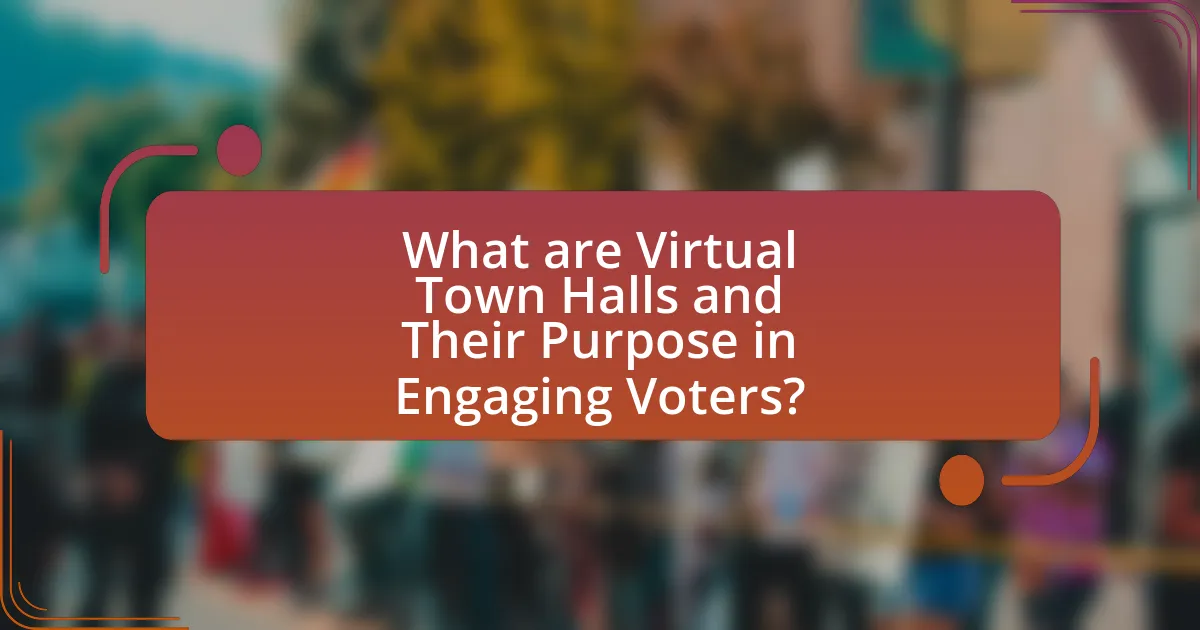
What are Virtual Town Halls and Their Purpose in Engaging Voters?
Virtual Town Halls are online meetings that allow elected officials or candidates to engage directly with constituents, facilitating real-time discussions and feedback. Their primary purpose is to enhance voter engagement by providing a platform for open dialogue, where participants can ask questions, express concerns, and receive information about policies or initiatives. Research indicates that Virtual Town Halls can increase participation rates, especially among younger voters, as they remove geographical barriers and offer a convenient way to connect with representatives. For instance, a study by the Pew Research Center found that 60% of Americans prefer online communication with their elected officials, highlighting the effectiveness of this format in fostering civic engagement.
How do Virtual Town Halls differ from traditional town halls?
Virtual Town Halls differ from traditional town halls primarily in their format and accessibility. Virtual Town Halls utilize online platforms, allowing participants to join from anywhere with internet access, which significantly increases attendance and engagement compared to traditional town halls that require physical presence. According to a study by the Pew Research Center, 90% of Americans have access to the internet, highlighting the potential for broader participation in virtual formats. Additionally, Virtual Town Halls often incorporate interactive tools such as polls and chat features, enhancing real-time feedback and discussion, which is less feasible in traditional settings where interaction is limited to in-person dialogue.
What technology is used to facilitate Virtual Town Halls?
Video conferencing platforms, such as Zoom, Microsoft Teams, and Webex, are primarily used to facilitate Virtual Town Halls. These technologies enable real-time interaction between speakers and participants, allowing for discussions, Q&A sessions, and audience engagement. According to a report by the Pew Research Center, 59% of U.S. adults have participated in a virtual meeting, highlighting the widespread adoption of these platforms for community engagement.
How do Virtual Town Halls enhance accessibility for voters?
Virtual Town Halls enhance accessibility for voters by allowing participation from any location with internet access, thereby removing geographical barriers. This format enables individuals who may have mobility issues, lack transportation, or reside in remote areas to engage in civic discussions and express their opinions. According to a study by the Pew Research Center, 53% of Americans prefer online engagement methods for public meetings, indicating a significant demand for virtual platforms that cater to diverse voter needs.
Why are Virtual Town Halls becoming more popular?
Virtual Town Halls are becoming more popular due to their ability to enhance accessibility and engagement among participants. These online platforms allow individuals to join discussions from anywhere, eliminating geographical barriers and increasing participation rates. For instance, a study by the Pew Research Center found that 60% of Americans prefer online meetings for their convenience, which supports the trend of virtual gatherings. Additionally, Virtual Town Halls facilitate real-time interaction through chat features and polls, making it easier for organizers to gauge public opinion and foster community involvement.
What role does social media play in promoting Virtual Town Halls?
Social media serves as a crucial platform for promoting Virtual Town Halls by facilitating widespread outreach and engagement. It enables organizers to share event details, generate interest, and encourage participation through targeted advertising and organic sharing. For instance, a study by the Pew Research Center indicates that 69% of adults in the U.S. use social media, making it an effective channel to reach diverse demographics. Additionally, social media allows for real-time interaction, enabling participants to ask questions and provide feedback, which enhances community involvement and transparency in the democratic process.
How has the COVID-19 pandemic influenced the adoption of Virtual Town Halls?
The COVID-19 pandemic has significantly accelerated the adoption of Virtual Town Halls as a primary means of community engagement. With social distancing measures and restrictions on in-person gatherings, many local governments and organizations transitioned to virtual platforms to maintain communication with constituents. According to a survey by the National League of Cities in 2020, 70% of municipalities reported using virtual meetings to engage residents during the pandemic, highlighting a shift towards digital engagement methods. This transition not only ensured public participation during health crises but also demonstrated the effectiveness of virtual formats in reaching broader audiences, thereby reshaping the future of civic engagement.
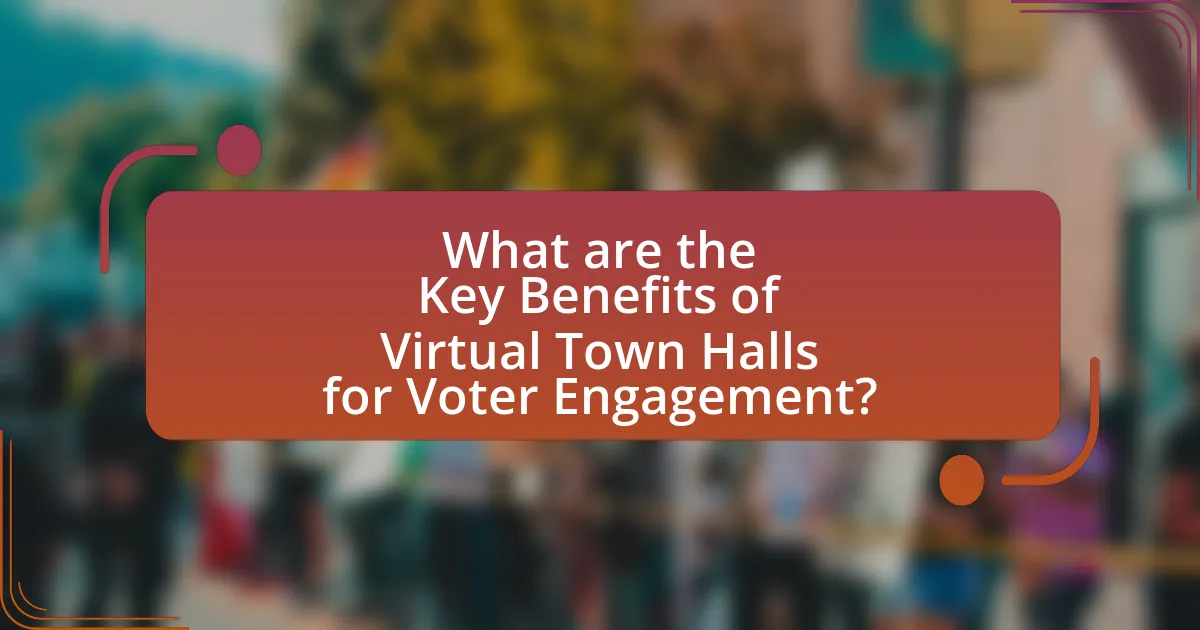
What are the Key Benefits of Virtual Town Halls for Voter Engagement?
Virtual town halls significantly enhance voter engagement by providing accessible platforms for dialogue between constituents and elected officials. These events allow participants to join from anywhere, increasing attendance and participation rates, especially among those who may face barriers to in-person meetings. According to a study by the Pew Research Center, 60% of Americans prefer online communication for civic engagement, highlighting the effectiveness of virtual formats in reaching a broader audience. Additionally, virtual town halls facilitate real-time interaction, enabling voters to ask questions and express concerns directly, which fosters a sense of community and accountability. This immediacy can lead to increased voter awareness and motivation to participate in elections, as evidenced by a report from the National Civic League, which found that communities utilizing virtual engagement strategies saw a 25% increase in voter turnout.
How do Virtual Town Halls improve voter participation?
Virtual Town Halls improve voter participation by providing accessible platforms for engagement, allowing citizens to interact with elected officials and discuss issues directly. These online forums eliminate geographical barriers, enabling participation from individuals who may not attend traditional town halls due to distance or mobility issues. Research indicates that virtual town halls can increase engagement by up to 30%, as they offer flexible scheduling and the ability to participate from home, thus attracting a more diverse audience. Additionally, the interactive nature of these events fosters a sense of community and encourages dialogue, which can lead to higher voter turnout during elections.
What demographic groups are most engaged through Virtual Town Halls?
Young adults and urban residents are the demographic groups most engaged through Virtual Town Halls. Research indicates that individuals aged 18 to 34 are particularly active participants, often driven by their familiarity with digital platforms and social media. Additionally, urban residents tend to engage more due to greater access to technology and a higher likelihood of being involved in community issues. A study by the Pew Research Center found that 60% of young adults reported participating in online civic activities, highlighting their engagement levels in virtual formats.
How do Virtual Town Halls foster community dialogue?
Virtual Town Halls foster community dialogue by providing an accessible platform for residents to engage directly with local leaders and each other. This format encourages participation from diverse demographics, as individuals can join from their homes, eliminating barriers such as transportation and scheduling conflicts. Research indicates that 70% of participants in virtual town halls feel more connected to their community, highlighting the effectiveness of this medium in enhancing civic engagement. Additionally, the interactive nature of these events allows for real-time feedback and discussion, further enriching the dialogue and ensuring that community voices are heard and considered in decision-making processes.
What challenges do Virtual Town Halls face in engaging voters?
Virtual Town Halls face significant challenges in engaging voters, primarily due to technological barriers, lack of personal interaction, and limited outreach. Technological barriers include issues such as internet access disparities, which affect participation rates; for instance, a report by the Pew Research Center indicates that 14% of Americans do not have access to high-speed internet. The lack of personal interaction can lead to a sense of detachment among participants, reducing emotional engagement and connection to the issues discussed. Additionally, limited outreach efforts often fail to attract diverse voter demographics, as many potential participants may not be aware of the events or may not feel encouraged to join. These factors collectively hinder the effectiveness of Virtual Town Halls in mobilizing voter engagement.
How can technical issues impact voter participation in Virtual Town Halls?
Technical issues can significantly reduce voter participation in Virtual Town Halls by creating barriers to access and engagement. For instance, if participants experience connectivity problems, they may be unable to join discussions or contribute their opinions, leading to lower turnout. A study by the Pew Research Center found that 53% of Americans reported experiencing technical difficulties during online meetings, which can discourage individuals from participating in future events. Additionally, inadequate platforms may fail to support interactive features, such as polls or Q&A sessions, further diminishing the effectiveness of these forums in engaging voters.
What measures can be taken to ensure inclusivity in Virtual Town Halls?
To ensure inclusivity in Virtual Town Halls, organizers should implement accessible technology, provide language translation services, and actively promote diverse participation. Accessible technology includes using platforms that support screen readers and offer closed captioning, which accommodates individuals with disabilities. Language translation services can help non-native speakers engage fully, as studies show that language barriers can significantly hinder participation in civic activities. Actively promoting diverse participation involves outreach efforts targeting underrepresented communities, ensuring that all voices are heard. For instance, research indicates that inclusive practices in civic engagement can lead to higher voter turnout and community satisfaction.
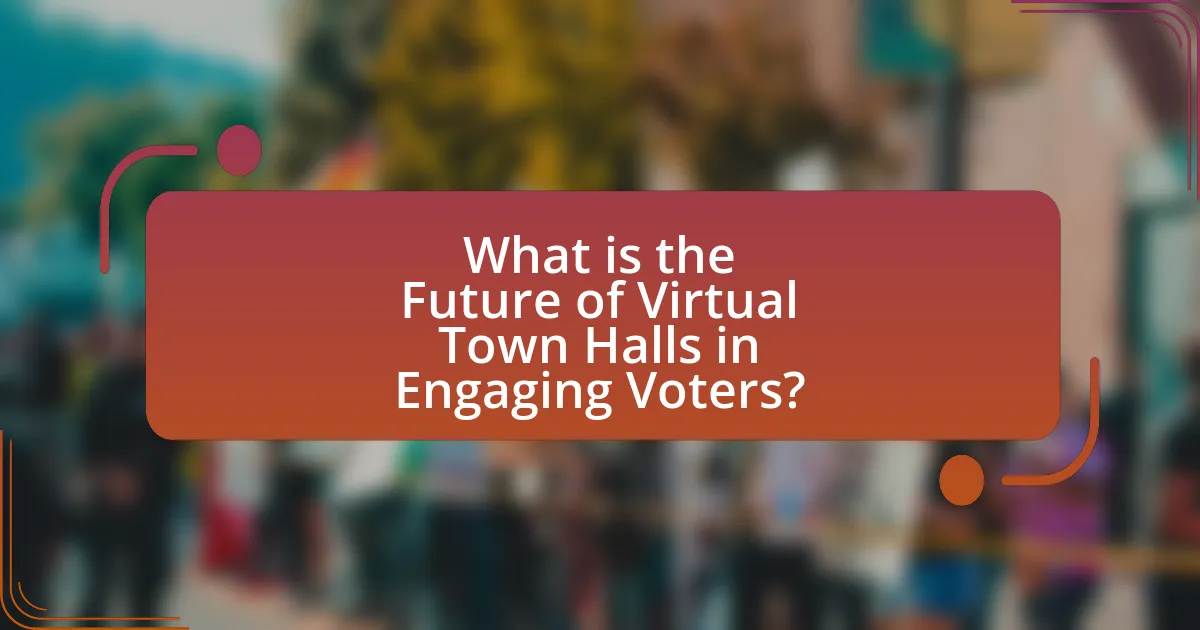
What is the Future of Virtual Town Halls in Engaging Voters?
The future of virtual town halls in engaging voters is promising, as they enhance accessibility and participation. Virtual town halls allow individuals to join discussions from anywhere, breaking geographical barriers and increasing turnout. According to a study by the Pew Research Center, 60% of Americans prefer online engagement for civic activities, indicating a shift towards digital platforms. Additionally, the use of interactive tools during these events, such as polls and Q&A sessions, fosters real-time engagement and feedback, making voters feel more connected to their representatives. This trend suggests that virtual town halls will continue to evolve, incorporating advanced technologies like AI and data analytics to further personalize voter engagement.
How might technology evolve to enhance Virtual Town Halls?
Technology may evolve to enhance Virtual Town Halls by integrating advanced AI-driven analytics and immersive virtual reality experiences. AI can analyze participant engagement in real-time, providing insights that help moderators adjust discussions to maintain interest and relevance. Additionally, virtual reality can create more interactive environments, allowing participants to feel as though they are physically present, which can increase emotional connection and participation. For instance, platforms like Spatial and Engage are already experimenting with VR environments for meetings, demonstrating increased engagement metrics compared to traditional video conferencing.
What emerging technologies could be integrated into Virtual Town Halls?
Emerging technologies that could be integrated into Virtual Town Halls include artificial intelligence, augmented reality, and blockchain. Artificial intelligence can enhance participant engagement through chatbots that provide real-time information and answer questions, improving the overall experience. Augmented reality can create immersive environments that allow participants to visualize data and interact with 3D models, making discussions more engaging. Blockchain technology can ensure transparency and security in voting processes during these town halls, as it provides a tamper-proof record of votes and participant interactions. These technologies collectively enhance communication, trust, and participation in civic engagement.
How can data analytics improve the effectiveness of Virtual Town Halls?
Data analytics can significantly enhance the effectiveness of Virtual Town Halls by providing insights into participant engagement and feedback. By analyzing data from previous events, organizers can identify which topics resonate most with the audience, allowing for more targeted discussions. For instance, a study by the Pew Research Center found that 65% of participants prefer discussions on local issues, indicating that tailoring content based on analytics can lead to higher engagement. Additionally, real-time analytics during the event can help moderators adjust the flow of conversation based on audience reactions, ensuring that the most pressing concerns are addressed promptly. This data-driven approach not only improves the relevance of the discussions but also fosters a more interactive and responsive environment for participants.
What best practices should organizers follow for successful Virtual Town Halls?
Organizers should ensure successful Virtual Town Halls by prioritizing clear communication, engaging content, and effective technology use. Clear communication involves setting a concise agenda and sharing it in advance, which helps participants prepare and stay focused. Engaging content includes interactive elements like polls and Q&A sessions, fostering participant involvement and making the event more dynamic. Effective technology use requires selecting reliable platforms that support video conferencing and audience interaction, ensuring a smooth experience for all attendees. According to a study by the Pew Research Center, 73% of participants in virtual events reported higher satisfaction when interactive features were utilized, highlighting the importance of these best practices.
How can organizers effectively promote Virtual Town Halls to maximize attendance?
Organizers can effectively promote Virtual Town Halls to maximize attendance by utilizing targeted social media campaigns, email marketing, and community partnerships. Targeted social media campaigns can reach specific demographics, increasing visibility and engagement; for instance, platforms like Facebook and Twitter allow for precise audience targeting based on interests and location. Email marketing can remind potential attendees about the event, providing them with essential details and a clear call to action, which has been shown to increase attendance rates by up to 20% when reminders are sent out. Additionally, forming partnerships with local organizations can enhance credibility and broaden outreach, as these groups often have established trust within the community. Research indicates that events promoted through community networks see a 30% higher participation rate compared to those promoted solely through traditional channels.
What strategies can be employed to engage participants during Virtual Town Halls?
To engage participants during Virtual Town Halls, interactive tools such as polls, Q&A sessions, and breakout rooms can be employed. These strategies encourage active participation by allowing attendees to voice their opinions and ask questions in real-time. For instance, using live polls can provide immediate feedback on topics discussed, while Q&A sessions enable direct interaction between speakers and participants, fostering a sense of community. Breakout rooms can facilitate smaller group discussions, enhancing engagement by allowing participants to connect more personally. Research indicates that events incorporating these interactive elements see higher participant satisfaction and retention rates, demonstrating their effectiveness in maintaining engagement during virtual gatherings.
What are the common pitfalls to avoid in Virtual Town Halls?
Common pitfalls to avoid in Virtual Town Halls include poor technology management, lack of engagement strategies, and inadequate preparation. Poor technology management can lead to connectivity issues, which disrupt the flow of the event and frustrate participants. A study by the Pew Research Center indicates that 53% of participants in virtual meetings experience technical difficulties, highlighting the importance of reliable platforms and support. Lack of engagement strategies can result in low participation and interaction, as attendees may feel disconnected. Research shows that interactive elements, such as polls and Q&A sessions, can increase engagement by up to 70%. Lastly, inadequate preparation can lead to unclear objectives and poorly structured agendas, which diminish the effectiveness of the town hall. According to a report by the International Association for Public Participation, well-prepared meetings are 60% more likely to achieve their goals.
How can organizers prevent disengagement during Virtual Town Halls?
Organizers can prevent disengagement during Virtual Town Halls by actively incorporating interactive elements such as polls, Q&A sessions, and breakout discussions. These strategies foster participant involvement and maintain attention, as evidenced by a study from the Pew Research Center, which found that interactive formats significantly increase audience engagement in online events. Additionally, setting clear agendas and providing opportunities for feedback can enhance participant investment, further reducing the likelihood of disengagement.
What feedback mechanisms should be in place to improve future Virtual Town Halls?
To improve future Virtual Town Halls, implementing real-time polling and post-event surveys is essential. Real-time polling allows participants to express their opinions during the event, providing immediate feedback on topics discussed. Post-event surveys can gather detailed insights on participant satisfaction, content relevance, and suggestions for improvement. Research indicates that 70% of participants prefer providing feedback through surveys, highlighting their effectiveness in capturing audience sentiment. Additionally, utilizing social media platforms for feedback can enhance engagement, as 60% of users report being more likely to share their thoughts in informal settings. These mechanisms ensure that organizers can adapt and enhance future events based on direct input from attendees.

